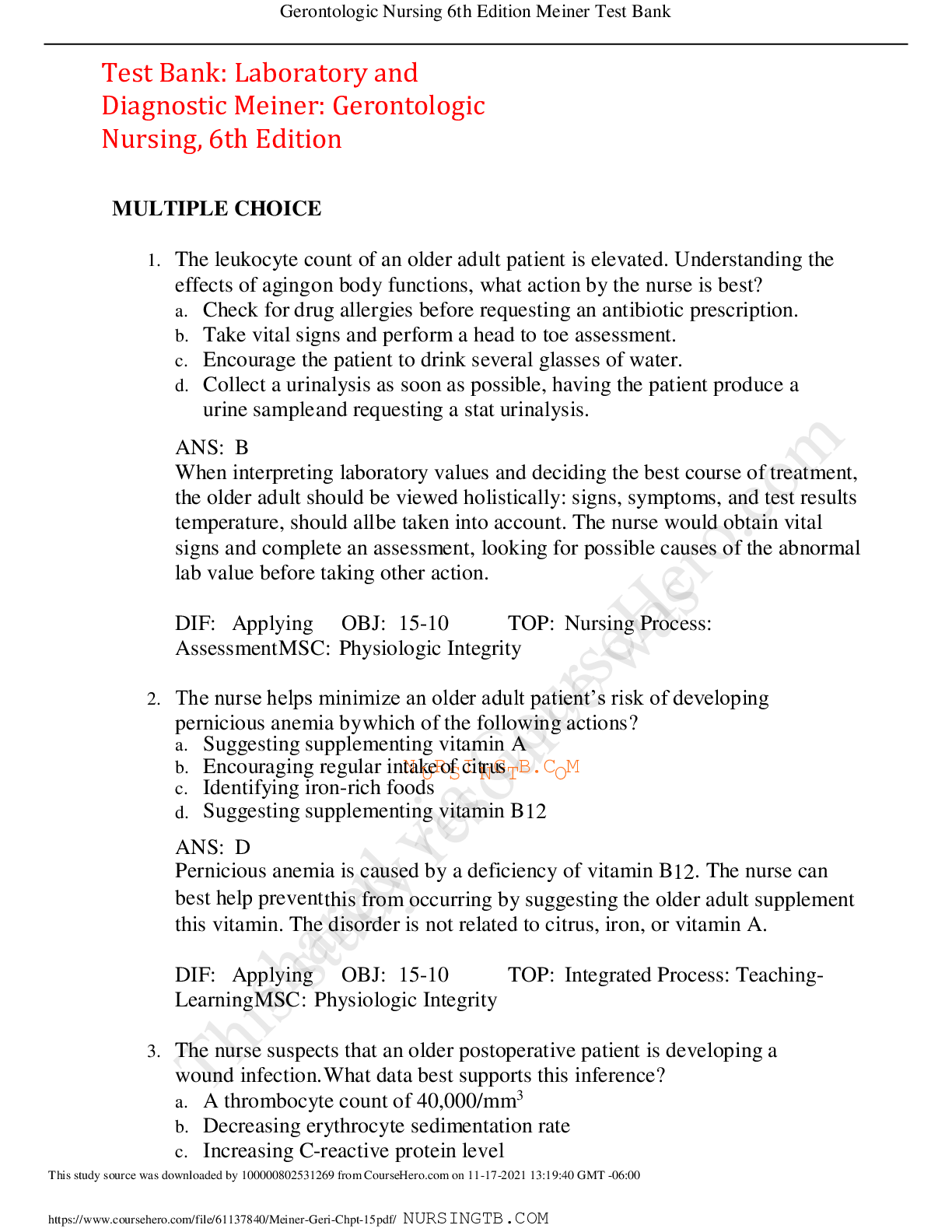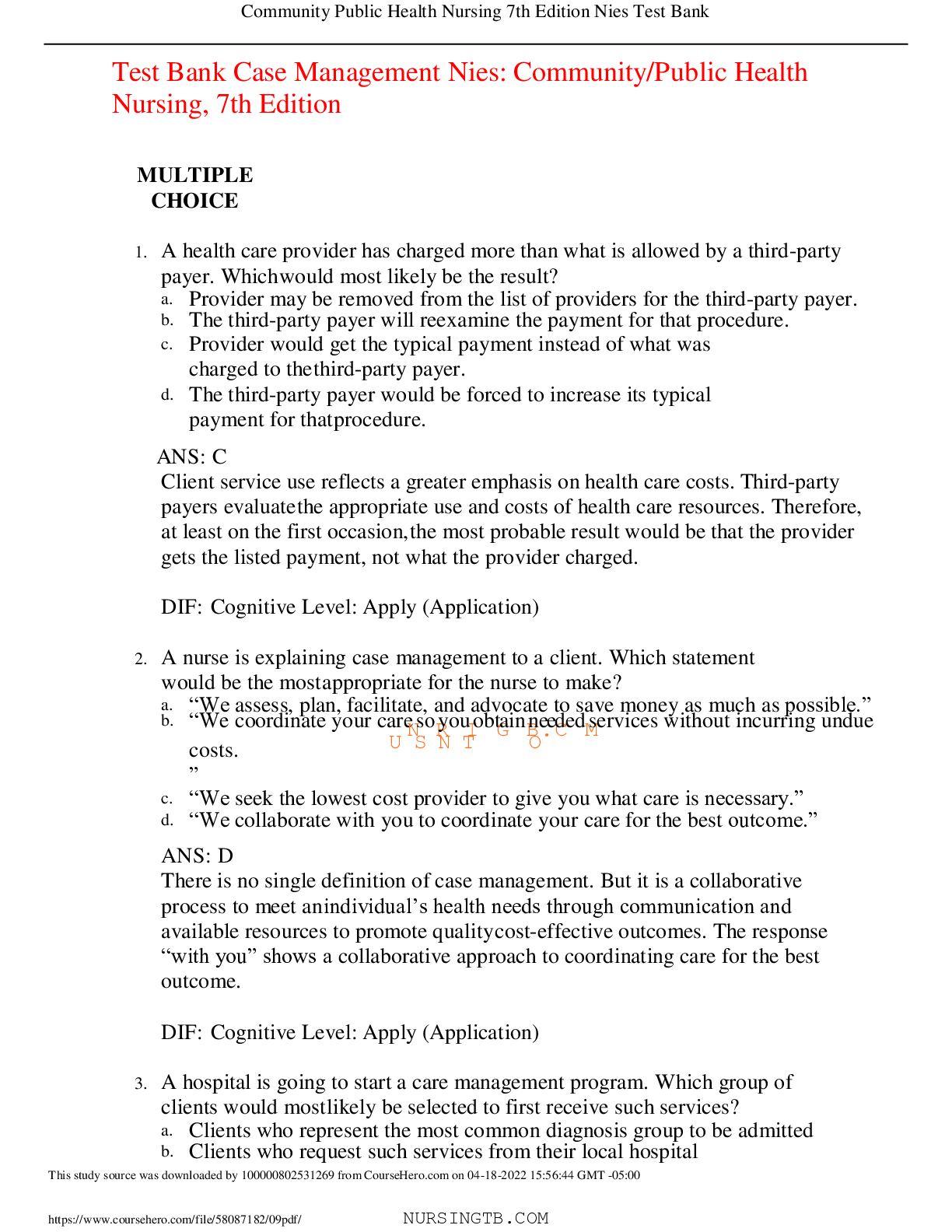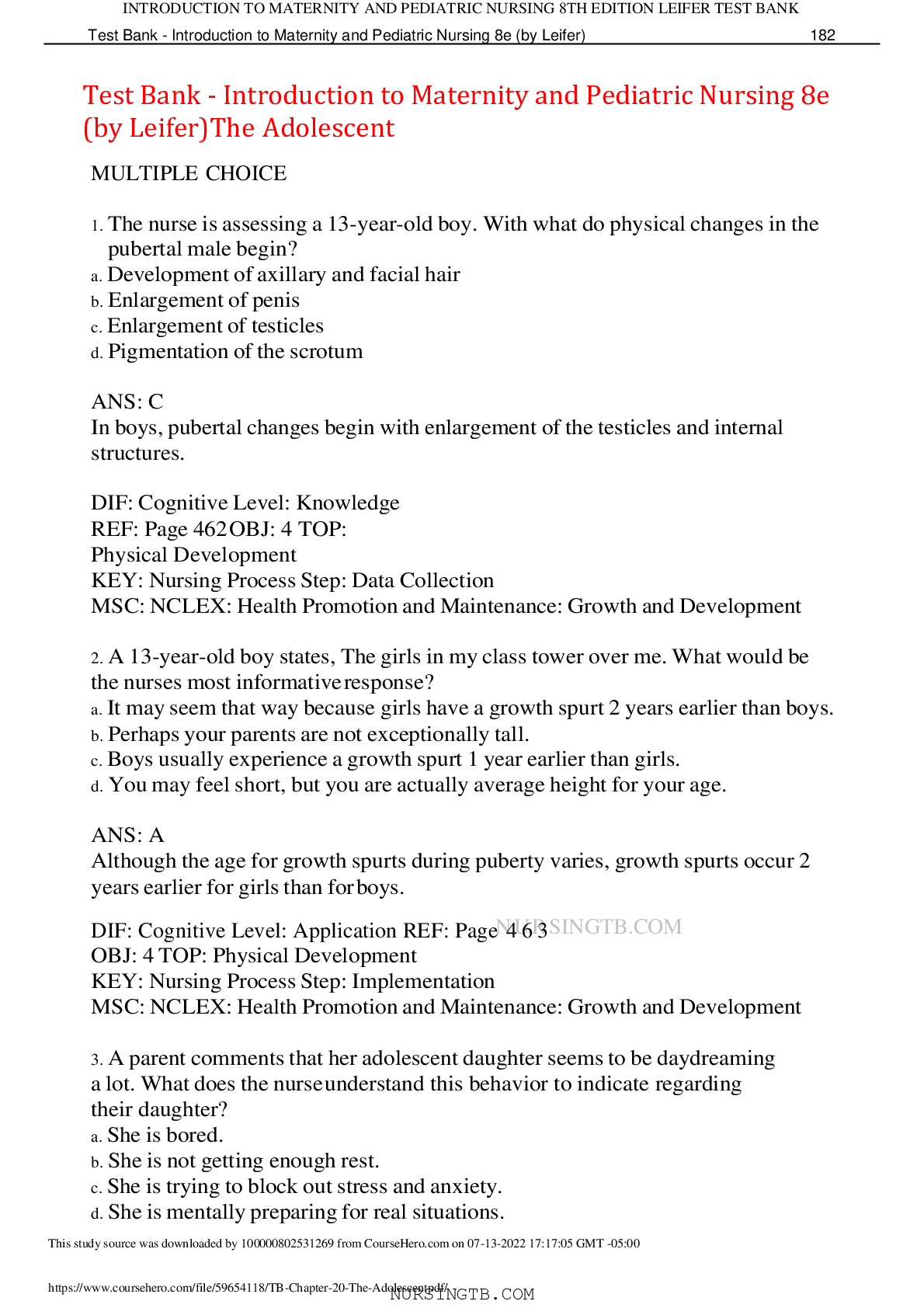*NURSING > TEST BANK > Test Bank: Introduction to Milieu Management Keltner: Psychiatric Nursing, 8th Edition,100% CORRECT (All)
Test Bank: Introduction to Milieu Management Keltner: Psychiatric Nursing, 8th Edition,100% CORRECT
Document Content and Description Below
Test Bank: Introduction to Milieu Management Keltner: Psychiatric Nursing, 8th Edition MULTIPLE CHOICE 1. During orientation the clinical nurse leader tells a novice nurse, “You will be invo... lved in purposeful creation of corrective learning experiences for all patients so as to provide a healing atmosphere.” The clinical nurse leader is explaining aspects of milieu-related concept? a. Balance b. Limit-setting c. A therapeutic environment d. Establishing behavioral norms ANS: C A therapeutic environment requires creation of corrective learning experiences to promote a therapeutic atmosphere. Limit-setting, balance, and norms are individual elements of the therapeutic environment and are answers that are too narrow. DIF: Cognitive level: Analyzing TOP: Nursing process: Implementation MSC: Client Needs: Safe, Effective Care Environment 2. Four nurses describe their unit environments. Which description can most clearly be identified as therapeutic? a. “My unit uses behavior modification to enhance patients’ social skills.” b. “My unit allows patients to test new behaviors in a secure environment.” c. “My unit helps patients deal with childhood issues by providing a safe setting.” d. “My unit allows patients toUdeaSl wNith pTersonalOissues without interpersonal stressors.” ANS: B The unit described in the correct answer provides a broad therapeutic focus for providing corrective experiences that helps patients recover. The distracters are too narrow in their therapeutic scope. DIF: Cognitive level: Applying TOP: Nursing process: Evaluation MSC: Client Needs: Safe, Effective Care Environment 3. Which nursing action best supports maintenance of a therapeutic environment? a. Creating therapeutic relationships with patients b. Providing purposeful structured activities c. Maintaining patient records and care plans d. Administering medication ANS: A A therapeutic environment requires nurses to be active and willing to engage in therapeutic relationships with patients. These relationships support patients’ development of coping and problem-solving skills. Maintaining records, administering medications, and providing activities are important in the therapeutic environment, but to a lesser extent than meaningful nurse-patient interactions. DIF: Cognitive level: Applying TOP: Nursing process: Implementation MSC: Client Needs: Psychosocial Integrity 4. While nurses are engaged in shift change report, one patient becomes loud and aggressive. This patient verbally harasses and frightens another patient. Which element of the therapeutic environment has been jeopardized? a. Norms b. Safety c. Balance d. Structure ANS: B Psychological safety is violated when one patient is allowed to harass another. Staff must set limits to protect the vulnerable patient. Norms, balance, and structure refer to other elements of the environment. DIF: Cognitive level: Applying TOP: Nursing process: Evaluation MSC: Client Needs: Psychosocial Integrity 5. Which nursing action best supports the maintenance of psychological safety for a patient with mental illness? a. Helping a depressed patient to inventory personal flaws b. Assisting a patient to change clothes after an episode of incontinence c. Allowing an anxious patient to pace in isolation and without interruptions d. Requiring a restrained patient to remain silent until restraints are removed ANS: B Assisting a patient to changeNcloRthesIafteGr anBe.pCisodMe of incontinence saves embarrassment for the patient, which contributes to a positive self-concept. Requiring a restrained patient to remain silent implies punishment rather than use of an external control until they are able to regain control. The other options are not therapeutic and do not promote psychological safety. DIF: Cognitive level: Applying TOP: Nursing process: Implementation MSC: Client Needs: Psychosocial Integrity 6. Which element of therapeutic environmental management has the highest priority? a. Clearly establishing norms and designating limits b. Scheduling purposeful activities throughout the day c. Creating an environment of psychological and physical safety d. Promoting a balance between patient dependence and independence ANS: C Safety is the most basic milieu element and therefore is of highest priority. Norms often contribute to safety. Activities and balance are other important milieu elements but are of lower priority. DIF: Cognitive level: Applying TOP: Nursing process: Planning MSC: Client Needs: Safe, Effective Care Environment 7. In which instance would it be most important for the nurse to set limits? a. An involuntarily hospitalized patient insists on being discharged. b. Two patients are found kissing in an obscure area of the unit. c. A patient with suicidal ideation asks to leave the unit. d. A depressed patient seeks daily telephone privileges. ANS: B Limits should be set on acting-out behavior, self-destructive acts, physical aggressiveness, sexual behavior, lack of compliance, use of illicit substances, and elopement. The correct answer is an example of sexual behavior. The distracters depict instances in which a therapeutic response is indicated from the nurse but not necessarily limit-setting. DIF: Cognitive level: Applying TOP: Nursing process: Implementation MSC: Client Needs: Safe, Effective Care Environment 8. A newly admitted patient is withdrawn and does not seek out interaction with staff or patients. Nursing interventions should focus on which element of the treatment environment? a. Norms b. Safety c. Structure d. Limit-setting ANS: C Structure refers to the physical environment, regulations, and daily schedule of classes and groups provided. The unit activities will provide an opportunity for the nurse to interface with the patient to develop a trusting relationship. The other treatment environment elements are important but are of lower priority for this patient. DIF: Cognitive level: Applying TOP: Nursing process: Implementation MSC: Client Needs: Psychosocial Integrity N R I G B.C M 9. Which statement about balance provides a basis for a nurse’s management of the therapeutic environment? a. Independence is best gained in increments. b. Independence is a fundamental right of all patients. c. Independence jeopardizes safety in an inpatient setting. d. Dependence is a characteristic of most persons with mental illness. ANS: A Balance is the process of gradually allowing independent behaviors in a dependent situation. Independence must be gained in increments to avoid overwhelming the patient. The distracters are false, since they do not describe the basis of balance. DIF: Cognitive level: Applying TOP: Nursing process: Planning MSC: Client Needs: Psychosocial Integrity 10. A patient demonstrating manic behaviors gathered other patients in the dayroom and gave a sales talk, pressuring others to purchase shares of stock in a gold mine. Which element of a therapeutic environment is jeopardized? a. Connection b. Exploration c. Structure d. Balance ANS: D The patient is violating the rights of others by being allowed to give unsolicited discourses and exert pressure on others. Balance is lacking when patients are not protected from the symptom expression of other patients. DIF: Cognitive level: Analyzing TOP: Nursing process: Evaluation MSC: Client Needs: Psychosocial Integrity 11. During a community meeting, a patient reacts negatively about having only two patient-accessible phones on the unit. Many other patients join in, all talking at the same time. The nurse requests that only one person talk at a time. The nurse’s request seeks to maintain what characteristic of a therapeutic environment? a. Norms b. Safety c. Balance d. Structure ANS: A Norms establish expectations that promote safety and trust in a therapeutic environment through sanctioning of socially appropriate behaviors. The other elements cannot be assessed as related to the scenario. DIF: Cognitive level: Applying TOP: Nursing process: Implementation MSC: Client Needs: Safe, Effective Care Environment 12. The framework of schedules, rules, and activities around which a therapeutic environment revolves is related to which associated term? a. Structure b. Balance c. Norms d. Safety ANS: A NURSINGTB.COM Structure refers to the physical environment, regulations, and daily schedule of classes and groups provided in a treatment setting. Structure provides the base on which the other elements are built. DIF: Cognitive level: Understanding TOP: Nursing process: Implementation MSC: Client Needs: Psychosocial Integrity 13. In a therapeutic environment, which norm exists? a. Opportunities for self-expression that relieve stress b. Expectations for socially acceptable behavior c. The behaviors most people display daily d. Shared experiences among patients ANS: B Norms are defined as specific expectations of behavior that pervade a setting. They are intended to promote community living through socially acceptable behaviors. The other explanations are not as comprehensive as the correct answer. DIF: Cognitive level: Understanding TOP: Nursing process: Planning MSC: Client Needs: Psychosocial Integrity 14. A patient has been bumping and pushing other patients. The nurse carefully explains to the patient that such behavior is unacceptable. The nurse has provided what characteristic of a therapeutic environment? a. Balance b. Limit-setting c. Personal control d. Environmental modification ANS: B Limit-setting provides a patient with a clear explanation of the acceptability or unacceptability of a behavior. Limit-setting reinforces norms and encourages the milieu concept of responsibility for self. The other options are not applicable. DIF: Cognitive level: Understanding TOP: Nursing process: Implementation MSC: Client Needs: Safe, Effective Care Environment 15. A nurse plans ways to promote patient safety and security. A proactive approach would include which intervention? a. Restricting psychotic patients’ rights b. Enforcing consequences of limit-setting c. Setting limits when a patient acts out aggressively d. Clearly communicating expectations for patients’ behavior ANS: D Proactive is the key word in this question. Communicating clear rules for expected behavior from the beginning reinforces norms and structure, and encourages self-responsibility. The other options are reactive. NURSINGTB.COM DIF: Cognitive level: Applying TOP: Nursing process: Planning MSC: Client Needs: Safe, Effective Care Environment 16. The nurse leading a social skills group is engaged in managing which environmental element? a. Balance b. Structure c. Accountability d. Risk management ANS: B By definition, the element of structure includes the schedule of planned therapeutic activities and groups. Balance refers to dependence-independence behaviors. Accountability and risk management are not identified elements of the therapeutic environment. DIF: Cognitive level: Understanding TOP: Nursing process: Implementation MSC: Client Needs: Safe, Effective Care Environment 17. Regarding effective milieu management, the Joint Commission on the Accreditation of Healthcare Organizations (JCAHO) standards mandate that intervention? a. Orientation programs detail safety issues and precautions. b. Patients’ room doors remain open during hours of sleep. c. Safety precautions are simple and apply commonsense behaviors. d. Patients’ personal belongings are kept in secure areas under staff control. ANS: A JCAHO standards require agencies to provide an orientation program that addresses safety issues. The other options are not part of the standards of this accrediting agency. DIF: Cognitive level: Understanding TOP: Nursing process: Implementation MSC: Client Needs: Safe, Effective Care Environment 18. Which adjective best characterizes custodial care? a. Paternalistic b. Beneficent c. Essential d. Safe ANS: A Custodial care focuses on activities of daily living, hygiene, nutrition, elimination, and safety needs rather than supporting patients to develop skills for self-care. Staff members decide what is best for patients. DIF: Cognitive level: Applying TOP: Nursing process: Evaluation MSC: Client Needs: Safe, Effective Care Environment 19. A psychiatric facility is “accredited by JCAHO.” Which asset would be expected? a. A 4:1 patient-to-staff ratio b. Private rooms for all patients c. Use of a therapeutic milieu treatment model d. Telephones for private patient conversations ANS: D NURSINGTB.COM JCAHO environment-of-care standards stipulate that telephones must be available to allow patients to conduct private conversations. The other options are not specified in JCAHO standards. DIF: Cognitive level: Understanding TOP: Nursing process: Evaluation MSC: Client Needs: Safe, Effective Care Environment MULTIPLE RESPONSE 1. Which aspects of the environment of a psychiatric unit comply with JCAHO environment-of-care standards? (Select all that apply.) a. Visitor badges b. Identification badges for employees c. Telephones located in enclosed booths d. Requiring patients to wear hospital-issue clothing e. Guidelines for staff interaction with media representatives ANS: A, B, C JCAHO standards mandate clothing suitable for the clinical environment, but they do not require patients to wear hospital-issue clothing. The other answers comply with standards. DIF: Cognitive level: Understanding TOP: Nursing process: Evaluation MSC: Client Needs: Safe, Effective Care Environment 2. Which research findings about the therapeutic environment of an inpatient psychiatric unit have implications for nursing practice? (Select all that apply.) a. Patients valued interactions with other patients. b. Patients perceived other patients as dissimilar from self. c. Hospitalization interferes with planning for the future. d. Patients failed to experience bonding with other patients. e. Hospitalization creates feelings of safety from self-destructiveness. ANS: A, E Findings from the work of Thomas and associates suggest that patients see the hospital as a refuge from self-destructiveness and are fearful of discharge from this safe environment. Furthermore, patients confirmed their identity with other patients (bonding), valued socialization with other patients, and perceived peer-administered therapy as the most valuable aspect of hospitalization. DIF: Cognitive level: Applying TOP: Nursing process: Planning MSC: Client Needs: Psychosocial Integrity 3. Which statements indicate that a patient understands the unit norms? (Select all that apply.) a. “I need quiet time after art therapy today.” b. “I will not yell during the community meeting.” c. “I realize that I need help with my problems.” d. “I will show up on time to take my medication.” e. “I will talk to staff if I get angry instead of punching somebody.” ANS: A, B, D, E Norms are specific expectatioNns Rof sIociaGlly Bac.ceCptaMble behavior intended to promote community living, such as behaving with civility during a community meeting, behaving in nonviolent ways, maintaining personal control, and accepting personal responsibility. The correct options are desirable behaviors related to norms rather than individual treatment goals. DIF: Cognitive level: Applying TOP: Nursing process: Evaluation MSC: Client Needs: Psychosocial Integrity [Show More]
Last updated: 1 year ago
Preview 1 out of 13 pages
Instant download

Instant download
Reviews( 0 )
Document information
Connected school, study & course
About the document
Uploaded On
Oct 18, 2021
Number of pages
13
Written in
Additional information
This document has been written for:
Uploaded
Oct 18, 2021
Downloads
0
Views
33






























